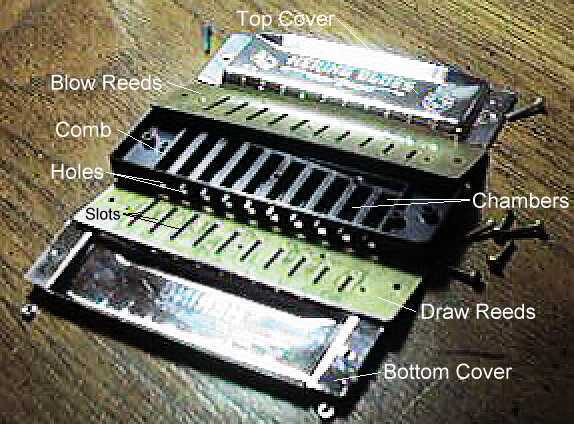Diatonic Harmonica Parts


Diatonic Harmonica Parts


The following table presents some basic definitions used when discussing
the harmonica and harmonica play. Many other less basic terms are
discussed in the section about diatonic
harmonica techniques.
|
|
|
| Bend | A lowering of the naturally played pitch of a reed caused by playing techniques. Draw notes can be bent on holes 1-6 and blow notes can be bent on holes 7-10. |
| Blow | Notes played by exhaling. The blow notes are created by the upper reeds (numbers up) where the reeds open inside the harp. |
| Chamber | The area or cell in the comb into which the reeds vibrate. The player breathes through the outer holes of the chambers to play the harmonica. See figure above. |
| Chromatic | A tuning that uses all 12 notes used in Western music. Chromatic harmonicas have a slide activated by a button that alter the reed that is sounded to enable fully chromatic play. Often refers to the type of harmonica, as opposed to a diatonic harp. |
| Closing Bend | A pitch lowering bend where the reed initially closes into its slot. |
| Comb | The body of a harp upon which the reed plates are attached. The comb has the holes or chambers into which you play. Combs are made of wood, plastic, or metal. See picture above. |
| Covers | The outer covers of the harmonica that attach to the comb. |
| Cup | The seal formed between the hands and the harmonica or mic. |
| Diatonic | A tuning that uses only the 8 notes from a major or minor scale. This is the tuning for normal 10-hole "short" harmonicas, also called diatonic harps. Often used to refer to the harmonica itself, as opposed to a chromatic harmonica. |
| Discrete Comb | A diatonic harmonica comb with a separate chamber for each reed. |
| Draw | Notes played by inhaling. The draw notes are created by the lower reeds (numbers up) where the reeds open outside the harp. |
| Gap | The space between a reed and its slot in the reedplate. See picture above. |
| Embouchure | The method of applying the lips and tongue to the harmonica. Often refers to any technique that manipulates the air stream. |
| Harp | Harmonica. Seems to originate from the early term "French Harp". Also called "Short Harp" and "Mouth Harp", as well as "Mouth Organ", "Tin Sandwitch", and "Mississippi Saxaphone". |
| Opening Bend | A pitch raising bend where the reed initially opens away from its slot. |
| Overblow | An advanced type of bend that plays the opposite reed in an opening rather than closing fashion. Overblows raise the pitch of the natural note, whereas normal bends lower the pitch. Overblows are available on holes 1-6 and overdraws are available on holes 7-10. |
| Position | Relates to the starting place (e.g. hole number) and manner (e.g. draw or blow) in which the root note of the scale is played. The natural notes of the harmonica when played in different positions yield characteristic modes. |
| Reed | A thin rectangular metal strip (normally brass) attached to a mounting plate that is activated by the players breath to spring back and forth through its slot, which chops the airstream and produces the harmonica's sound. See picture above. |
| Reed plate | The mounting plate for the harmonica reeds. Normally brass. See picture above. |
| Resonance | An amplification effect due to sound waves echoing and superimposing to reinforce certain audible frequendies. |
| Slot | A rectangular hole in the reed plate just slightly larger than its reed. The reed vibrates through its slot to produce the harmonica sound. See picture above. |
| Tab | Short for tablature. A shortcut notation that indicates how to play a note on the harmonica. This is different from standard musical notation, which indicates what note to play including its relative duration. |
| Tremolo | Pulsations of air pressure that cause a wavering effect to the loudness of the sound. Often referred to as vibrato, and often mixed with vibrato to produce a note oscillation effect as used by singers. When both vibrato and tremolo are present, usually the term vibrato is used. |
| Vibrato | Slight fluctuations of pitch produced by a slight wavering movement of part of the embouchure affecting the air stream. Sometimes referred to as tremolo, and often used with tremolo to produce a note oscillation effect as used by singers. When both vibrato and tremolo are present, usually the term vibrato is used. |